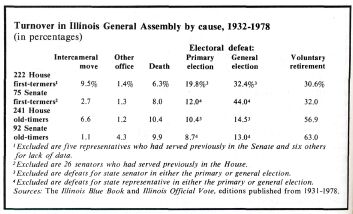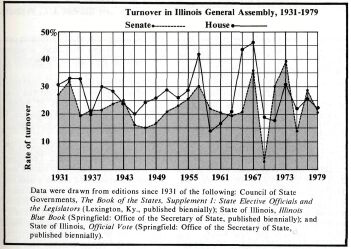 |
Home | Search | Browse | About IPO | Staff | Links |
 |
Home | Search | Browse | About IPO | Staff | Links |
| What's the turnover rate in the Illinois legislature? | The record shows Illinois has had a remarkably stable legislature over the last 47 years. Salaries do not seem to be a major cause of legislative turnover |
ADVOCATES of the recent and controversial pay raises for state legislators argued for the hikes on a number of grounds. The pay hike was justified, they said, because the workload for legislators has increased significantly in recent years. Longer sessions, more committee work, and increased public pressure had combined to make service in the House and Senate a demanding responsibility which left little time for families or private business. On that basis, the pay hike may well have been justified, rewarding full-time professionals for full-time efforts.
Salaries as a factor
But another of the arguments for the pay increase is much less convincing, given the history of legislative turnover in Illinois. This contention is that higher salaries are necessary to attract and retain qualified, competent senators and representatives. Without the incentive of competitive salaries, the argument goes, Illinois legislators will defect to private business or other more lucrative pursuits, leaving government in the hands of uncommitted, marginally qualified people. But the record of turnover in the Illinois House and Senate tends to refute that argument, suggesting that Illinois has had a remarkably stable legislative membership over the last 47 years, and that the recent pay raise is unlikely to have a significant effect in terms of reducing turnover.

|
What the record shows, first of all, is that from 1931 to 1978, Illinois ranked third among the states in terms of stability of combined House and Senate membership, behind only New York and California. During that period, the overall turnover in the Illinois General Assembly averaged 25.2 percent as compared to a composite average of 40.4 percent for all the 50 state legislatures and 24.6 percent for both New York and California. (For each chamber of a state legislature, turnover was measured as the proportion of new members out of total membership on the basis of biennial election results.) Turnover in the Illinois Senate over those 47 years was 23.4 percent while for the House it was 26.9 percent. Both averages were substantially lower than those for all the 50 state Senates and 49 state Houses, which were 37.7 percent and 43.2 percent, respectively. |
The accompanying graph shows the variations in turnover rates for the Illinois Senate and House from 1931 to the present. With the exception of a few dramatic fluctuations, the percentage of new members in each chamber has remained within the relatively low and narrow range of 18 and 30 percent since 1931. The peaks are easily explained as the results of the massive shift toward the Democratic party during the early tide of the Great Depression (1932), the at-large election of state representatives and the Johnson landslide (both in 1964), or legislative reapportionments which insured a higher rate of first-term legislators (1955, 1965 and 1971).
Reasons for turnover
An examination of the causes for legislative turnover in Illinois reveals the not unexpected fact that electoral defeat and voluntary retirement are responsible for the vast majority of departures from the House and Senate. As the data in the table indicate, these two elements
18 / May 1979 / Illinois Issues
together account for 82.8 percent of the turnover among first-term representatives, 88 percent among first-term senators, and 84.7 percent and 81.8 percent among the old-timers (12 years of service or more) in the Senate and House, respectively. More importantly, this data clearly demonstrates that electoral defeat (particularly in the general election) contributed the most to turnover among first-term legislators, while voluntary retirement was the major factor in the departures of the old-timers.
Old-timers and new blood
| The majority of departures among the less seasoned senators and representatives, in other words, were involuntary, suggesting that dissatisfaction with pay and other benefits has not been an important factor among younger legislators. And while the voluntary retirements of the experienced senators and representatives may reflect some degree of such dissatisfaction, there is reason to believe that many simply retired from work rather than to other, more profitable pursuits. Even assuming that some of these experienced legislators were enticed into other occupations by higher pay, it can be argued that it would be undesirable to "congressionalize" the General Assembly and make it a permanent occupation for full-time politicians. There is, after all, much to be said for regular and reasonable injections of new blood into the body politic. | 
|
What emerges from this survey is, first of all, the fact that legislative turnover in Illinois has been and continues to be low, both absolutely and relative to other states. If a significant component of professionalism is experience, in other words, Illinois has always had a more professional legislature than most other states. It would take a great many more incentives to drive the turnover rate much lower, and there is a real question about further "congnresionalizing" the General Assembly, any case.
The legislative salary increase may, in short, be justified as increased compensation for increases in workload and responsibilities. But those who defend it as insurance against massive turnovers in legislative membership have a much less compelling case. The record shows that Illinois has a long tradition of stability in the House and Senate, and that the recent pay increases would have only a marginal effect on the quality and continuity of the Illinois House and Senate.
Kwang S. Shin is faculty assistant and David H. Everson is associate professor of political studies at the Legislative Studies Center, Sangamon State University, Springfield. Shin is coauthor of an article, "Membership turnover in U.S. State Legislatures: 1931-1976" which appeared in the February issue of Legislative Studies Quarterly, an international journal which studies representative assemblies.
19 / May 1979 / Illinois Issues
|
|